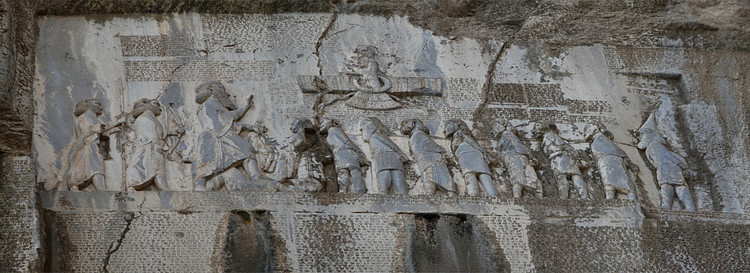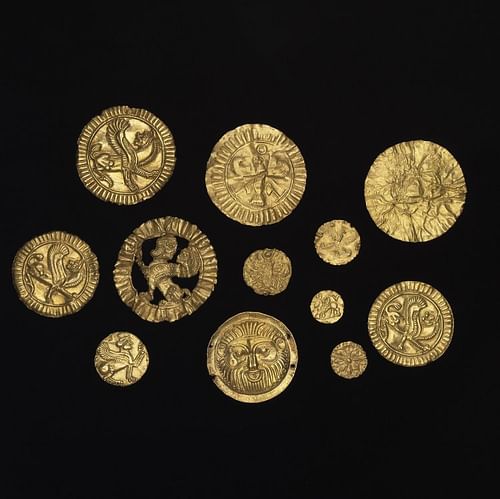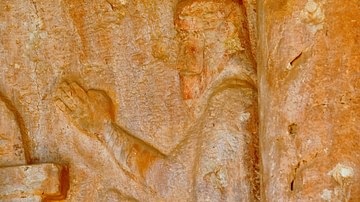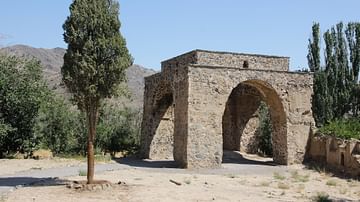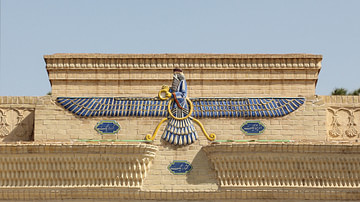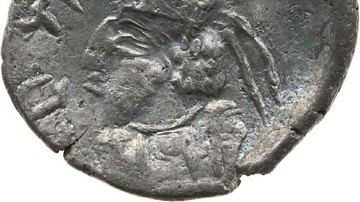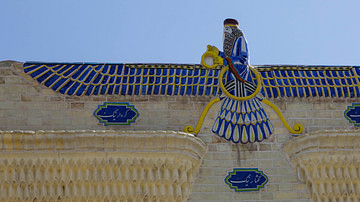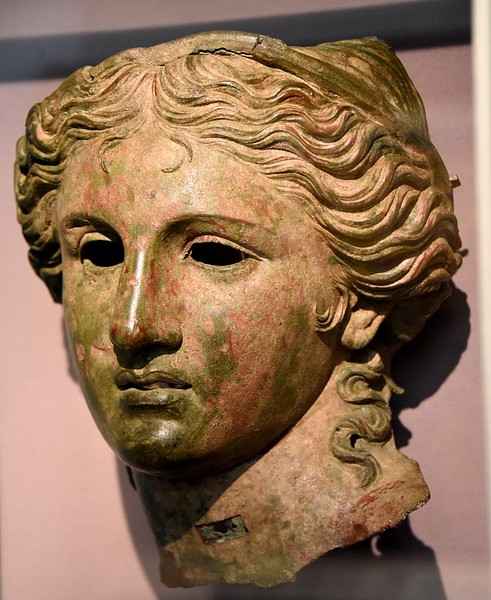
Anahita is the ancient Persian goddess of fertility, water, health and healing, and wisdom. Owing to her association with life-giving properties, she also came to be connected with ancient Persian warfare as soldiers would pray to her for their survival before battle.
She is also known as Ardvi Sura Anahita, Anahid, Anahit, and Anaitis. Anahita was among the most popular and widely venerated deities in Early Iranian Religion from perhaps c. 8th century BCE (certainly by the 4th century BCE) and survived the religious reforms of the prophet Zoroaster (c. 1500-1000 BCE) as an emanation of the one god Ahura Mazda rather than as the deity she had been before.
She is associated with powerful goddesses of other ancient civilizations such as Saraswati of the Hindu tradition, Inanna/Ishtar of Mesopotamia, Sauska of the Hurrian-Hittites, Astarte of the Phoenicians, Aphrodite of the Greeks, and Venus of the Romans. She had more temples and shrines dedicated to her than any other Persian goddess, even after the advent of Zoroastrianism which established a monotheistic paradigm in the region, and people regularly paid her homage at these sites until the fall of the Sassanian Empire to the Muslim Arabs in 651 CE.
Even afterwards, she continued to be venerated under the name Bibi Sahrbanu, legendary widow of the Shia Islamic hero and martyr Husayn ibn Ali (626-680 CE) who fell at the Battle of Karbala (680 CE), an event commemorated in the present day in the festival of Ashura. Anahita's shrines, whether under the name of Bibi Sahrbanu or another, continue to be visited by supplicants in the present day.
Origin, Character, Depiction
Anahita probably existed in some form prior to the 3rd millennium BCE when ancient Persian religion developed in the region of Greater Iran (the Caucasus, Central Asia, South Asia, and West Asia). The Indo-Iranians (Aryans) who eventually settled in Persis had been part of a larger migratory group which included the Indo-Aryans who would settle northern India, and at this time, Anahita and the Hindu goddess Saraswati (presiding over knowledge, learning, music, and wisdom) were probably the same deity.
At some point, the Indo-Iranians developed their religious belief system to reflect a cosmic clash between the forces of order, light, and goodness with those of chaos, darkness, and evil. The gods of their pantheon were created by the chief god and Lord of the Universe, Ahura Mazda, to help the people who were then were expected to return the favor by choosing to follow Ahura Mazda and his fellow gods and reject the lies of his adversary Angra Mainyu (also known as Ahriman), chief of the demons and evil spirits.
Ahura Mazda was the first, uncreated, deity who drew order out of chaos through the act of creation in seven steps: sky, water, earth, vegetation, animals, human beings, and fire. After the creation of fire, Ahura Mazda generated the gods out of his own essence thus making all the gods his children even though they are not all addressed as such. Anahita was always given a special reverence in being identified clearly as Ahura Mazda's daughter.
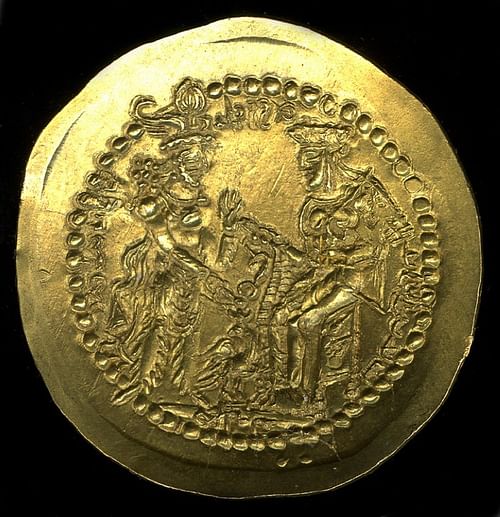
She was closely associated with Mithra (god of covenants, contracts, and the rising sun) who encouraged piety and a proper relationship with the gods. Anahita also played a part in religious devotion as the goddess of wisdom and life-giving water. Mithra was always among the most popular gods of the Persians but Anahita came to be revered at more shrines and temples than any other. Scholar John R. Hinnells comments:
It is natural that many religions should imagine the source of life and fruitfulness in female form. In Persia, the goddess Ardvi Sura Anahita, the strong undefiled waters, is the source of all waters upon the earth. She is the source of all fertility, purifying the seed of all males, sanctifying the womb of all females, and purifying the milk in the mother's breast. From her heavenly home she is the source of the cosmic ocean. (27)
The cosmic ocean, according to the Zoroastrian creation text Bundahisn, originated at the top of Mount Hara (Hara Berezaiti), ran down through the world, and divided itself into fresh and saltwater to provide for all the creatures on the planet. This ocean was Anahita herself and so any veneration of water was an honor bestowed on the goddess in the same way that the veneration of fire was not fire-worship but recognition of the god of fire, Atar. As the source of all water in the world, and the water itself, she was seen as pure, swift in motion, and powerful; her name, in fact, reflects the dual concepts of moistness and strength.
She is regularly depicted as a beautiful woman in a white gown embroidered with gold, wearing golden earrings with a gold necklace around her throat and a golden crown. She carries the barsom twigs of life in one hand (representing the bounty of the earth and, so, fertility) and drives a chariot drawn by four horses of wind, rain, cloud, and sleet. She was protected in her journeys across the sky – and between heaven and earth – by Mithra and other similar deities and provided the sun god, Hvar Ksata, with all the essential elements through which he was able to sustain life on earth.
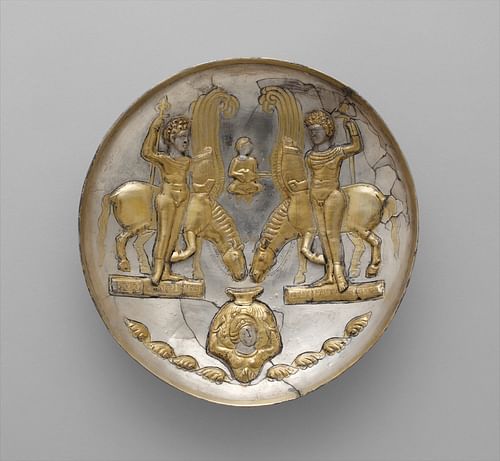
The early religion emphasized the immanence of the gods and rituals were conducted outdoors – since no house of worship was thought adequate and could not contain a deity – and centered on the four elements which were, in one way or another, represented by a god or goddess. Rituals were presided over by the priestly class (the Magi) and began by invoking Atar through the flames kindled on the altar; the ritual would end with the invocation of Anahita and the use of water.
During this time, outdoor shrines to Anahita were raised at various locations – most often, naturally, by springs, streams, and rivers – but she had no temples. Ancient sites now associated with her – such as Kangavar and Bishapur – may have been places dedicated to her worship at this time but any temples thought to have been built at either site would have come much later and recent scholarship, actually, challenges the interpretations of the ruins at these sites as temples, let alone as temples to Anahita.
Zoroastrianism & the Achaemenid Empire
The early religion's veneration of the various gods eventually came to include one's ancestors and the religious bureaucracy was able to capitalize on this by offering services in honor of those who had passed on. Through tithes and fees charged for prayers to the gods, blessings given, and incantations recited to ancestors – among other services such as the sale and blessings of statuettes, amulets, and icons – the priestly class became wealthy to the point where they became the most powerful financial institution in the region.
Zoroaster was one of these magi but is said to have had a number of problems with their behavior and policies. At some point between c. 1500-1000 BCE, he received a revelation from Ahura Mazda through a being of light, Vohu Manah (“good purpose”) who appeared to him on a riverbank. Vohu Manah identified himself as a direct representative of Ahura Mazda and told Zoroaster that the prevailing religious understanding and practice was wrong. Ahura Mazda, he said, was the only god and the worship of many others alongside him was in error. Zoroaster initiated reforms which, after the conversion of the king Vishtaspa, were accepted and became the monotheistic religion of Zoroastrianism.
The many gods of the old religion were reorganized – some were eliminated, some considered evil – so that now deities like Mithra or Anahita became emanations of the one god and lost their divine status (though not their inherent divinity). One could still worship Anahita but now with the understanding that one was worshipping an aspect of Ahura Mazda, not an actual goddess. This practice would be similar to the later development of veneration of the Virgin Mary in Catholicism; one is not worshipping Mary herself but is honoring an aspect of the Divine which she represents.
By the time Cyrus II (the Great, r. c. 550-530 BCE) founded the Achaemenid Empire (c. 550-330 BCE), Zoroastrianism was firmly established in the region but this does not necessarily mean that Cyrus was a Zoroastrian nor that the religious freedom he famously encouraged was based on that religion. References in Cyrus II's inscriptions to Ahura Mazda could as easily be alluding to the king of the gods of the old religion as the one god of Zoroastrianism. This same possibility holds for Cyrus II's successors such as Darius I (the Great, r. 522-486 BCE) and Xerxes I (r. 486-465 BCE) though most scholars believe they were Zoroastrians. This belief may be unfounded, however, since Darius I, in his famous Behistun Inscription, invokes Ahura Mazda and “the other gods”, clearly suggesting a reference to the pre-Zoroastrian religion. Xerxes I's invocations of Ahura Mazda can be interpreted in a similar fashion.
Much has been made of the inscriptions of the Persian king Artaxerxes II (r. 404-358 BCE) which reference Ahura Mazda, Anahita, and Mithra (in that order) and call on them as a powerful protection of the king's works and personal safety. These inscriptions, some scholars claim, make it clear that Zoroastrianism was a polytheistic faith and that these three deities were a kind of Zoroastrian Trinity. This claim is untenable, however, because it starts with the assumption that Artaxerxes II was a Zoroastrian when he may not have been any more than Darius I or Xerxes I were. Further, even if he was, the inscriptions can as easily be interpreted as the king calling on Ahura Mazda and his emanations of wisdom and protection – Anahita and Mithra.
According to the historian Berosus (3rd century BCE), Artaxerxes II was the first Achaemenid monarch to publicly erect statues of Anahita in the temples of many of the major cities of the empire. This, scholars claim, is evidence of a widespread and popular cult of the goddess, and this interpretation is sound in that popular cults of various deities have been positively identified based on iconography found at religious sites.
None of Artaxerxes II's predecessors had erected monuments to any gods in keeping with the Zoroastrian – and pre-Zoroastrian – belief that the gods should not be represented in artworks nor “confined” to any of the works of human beings such as temples. The fact that Berosus mentions temples to Anahita as well as statuary strongly suggests a paradigm shift during Artaxerxes II's reign when direct worship of Anahita in a temple was not only acceptable but popular and widespread. Ancient writers mention temples to the goddess in regions spreading from Iran to Armenia to Cilicia to Syria and elsewhere.
Parthian & Sassanian Empires
The Achaemenid Empire fell to Alexander the Great in 330 BCE and was succeeded by the Seleucid Empire (312-63 BCE) during which worship of Anahita – and possibly her cult – continued to flourish. Temples to Anahita at this time are described by ancient historians (such as the Roman writer Arrian, 4th century BCE) as opulent structures ornamented in gold and silver. These temples received gifts from wealthy supplicants of various items made of precious metals – statuary, figurines, weapons, plaques, coins – which were either part of the one-tenth tithe temple tax required of all people living in the vicinity of the temple for its maintenance or offerings to the goddess in hopes of answered prayers. The famous Oxus Treasure is thought to have originally been part of such a temple's treasury before it was removed and buried on the bank of the Oxus River.
The Seleucid Empire was succeeded by the Parthian Empire (247 BCE-224 CE) and, during this period, Anahita underwent a significant change. Although she was still seen as a goddess of fertility, water, health, and wisdom, her defining role was as a goddess of war. The Parthians decentralized the ancient Persian government and the satraps (governors) of the different regions had greater autonomy than during the Achaemenid Period. It is thought that Anahita represented the underlying unity of the empire in defense of the realm, symbolically, in place of a centralized government that demanded conformity.
This same paradigm held during the succeeding Sassanian Empire (224-651 CE) when Anahita continued as a war goddess. The Sassanians made Zoroastrianism their state religion but, in keeping with Persian tradition going back to the Achaemenid Period, allowed for freedom of religious expression throughout the empire. Part of this expression seems to have been a continuation of Anahita's cult. It is difficult to reconcile the widespread worship of the goddess with the Zoroastrian concept of her as simply an “emanation” of the one true god Ahura Mazda, and it is far more likely she was worshipped as a goddess in her own right at this time.
It is possible – and also quite likely – that Anahita's popularity and continued veneration during this period was due to the belief system of Zorvanism (usually considered a “heretical sect” of Zoroastrianism). Zorvan was a minor deity of time in the pre-Zoroastrian religion of Iran who, at some point in the late Achaemenid Period, became elevated to the position of supreme god. In Zorvanistic belief, Zorvan – the personification of Time – was the first uncreated being who gave birth to the twins Ahura Mazda and Ahriman.
Ahriman was given control of the world for a certain period but Ahura Mazda would then win it back and ultimately prevail. Zorvanism resolved the theological problem of the origin of evil in that Ahura Mazda was still the all-good creator and Ahriman his opponent but Ahura Mazda had not created evil, nor had evil come forth from him; all things proceeded from time, whose very essence is change and mutability, and so Ahriman and his schemes were simply a result of his birth from Time, not from anything having to do with the benevolent Ahura Mazda.
In this belief system, a goddess like Anahita would have been created by Ahura Mazda – just as in Zoroastrianism – but would have had a higher status since Ahura Mazda himself was a created being, born of Time, just as she was a created being born of Ahura Mazda. The early Sassanian kings – Ardashir I (r. 224-240 CE) and Shapur I (r. 240-270 CE) – were probably both Zorvanites even though they publicly supported Zoroastrianism as the state religion. Ardashir I is said to have sent the heads of his defeated opponents to one of Anahita's shrines for display in keeping with her role as a war goddess who would have been pleased by such offerings.
Under the reign of Bahram I (272-273 CE), Anahita's temples were converted to Zoroastrian fire temples but her shrines were kept and worship continued. Anahita's popularity during the Sassanian Period is known to have been so widespread that modern-day scholars have repeatedly interpreted Sassanian depictions of mortal women as representations of Anahita in her various aspects. These artworks have now been identified as depictions of Sassanian queens and noblewomen, not of Anahita, for the most part.
Conclusion
The Sassanian Empire fell to the Arab Muslims in 651 CE and, afterwards, Zoroastrianism as well as every other aspect of Persian culture – including worship of Anahita – was suppressed. In time, the legend of Bibi Shahrbanu (“Lady of the Land” or “Lady of the King's Lands”) developed which identified a daughter of the last Sassanian king, Yazdegerd III (r. 632-651 CE) as the widow of the Shia Muslim hero and martyr Husayn ibn Ali who fell at the Battle of Karbala in 680 CE. Sites and shrines previously dedicated to Anahita were afterwards associated with Bibi Shahrbanu and, in fact, remain so to the present day, especially the shrine at Shah-e Ray, Tehran Province, Iran.
Anahita's name was eventually forgotten, replaced by Bibi Shahrbanu's, though her shrines continue to draw visitors and supplicants who touch the waters and rocks associated with divinity in hopes of answered prayers. Her legacy continues, however, in the rites of modern-day Zoroastrianism where she is still honored in the rituals which include the ancient veneration for the goddess of water who provided the essential elements for life on earth.
